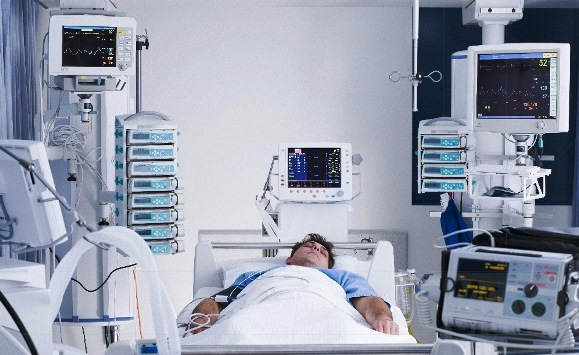Key Concepts
The treatment of acute, life-threatening disorders, usually in intensive care units. Critical care medicine has been practiced informally for many decades in trauma centers, postanesthesia recovery rooms, coronary care units, delivery rooms, emergency rooms, and postoperative areas. The facilities and trained personnel available in the intensive care unit (ICU) [see illustration] permit extensive monitoring of physiological variables, organization of multidisciplinary diagnostic and therapeutic plans (often requiring complex methods of execution), administration of therapy to predetermined goals, and expert nursing care. Many advances in medicine have increased the need for critical care. Among them are heart operations, transplantation of various organs, and cancer chemotherapy. See also: Chemotherapy and other antineoplastic drug treatments; Clinical pathology; Emergency medicine; Medicine; Nursing; Transplantation biology; Trauma

Critical care runs counter to the traditional division of specialties by organ or organ system. Specialists in critical care undergo training beyond a primary qualification (internal medicine, surgery, anesthesia, or pediatrics) and must be able to manage acute respiratory, cardiovascular, metabolic, cerebral, and renal problems, as well as infections. The patients may be newborns, children, or adults suffering from trauma or acute life-threatening disease. Patients having failure of multiple organs, complicated medical problems, disorders encompassing several medical specialties, or a need for 24-hour care often become the responsibility of the critical care specialist. Another aspect of critical care is the provision of life-sustaining therapy. Components include administration of intravenous fluids, provision of nutritional support, and control of infections. See also: Anesthesia; Disease; Infection; Surgery
The intensive care unit is the most labor-intensive, technically complex, and expensive part of hospital care. The single most useful function of the intensive care unit is to provide life-support systems for desperately ill patients who would not survive without them. Such systems include mechanical ventilation, cardiopulmonary resuscitation (which may entail the use of cardiac drugs, fluids, electrocardiographic monitoring for cardiac dysrhythmias, and defibrillation by electric shock), peritoneal dialysis and hemodialysis, circulatory support with intra-aortic balloon pumping, and extracorporeal membrane oxygenation. However, many patients in intensive care units have infections that are part of their primary disease or were acquired in the hospital (these latter infections are termed nosocomial). The nosocomial infections are particularly difficult to eradicate because they are usually resistant to most antibiotics. Therefore, the control of the environment in the intensive care unit is a major problem. Cross-contamination between various patients and between patients and personnel must be constantly monitored to prevent outbreaks of infection. See also: Antibiotic; Drug resistance; Nosocomial disease
In addition, various types of crises are managed by critical care specialists. These include upper gastrointestinal hemorrhage, acute abdominal crises (for example, acute pancreatitis, intestinal obstruction, and stones of the kidney or ureter), cardiac emergencies, coma management, acute endocrine disorders (for example, excessive or deficient thyroid hormone secretion), injuries (for example, trauma from automobile accidents, penetrating injuries from violent crimes, and blunt trauma from falls or assaults), hepatic failure and metabolic problems (for example, alcoholic cirrhosis, viral hepatitis, drug reactions, and liver failure), and pulmonary problems [for example, pneumonia, asthma, pulmonary embolism (blood clot in the lung), smoke inhalation, and near-drowning]. See also: Asthma; Cirrhosis; Embolism; Hemorrhage; Liver disorders; Metabolic disorders; Pneumonia





